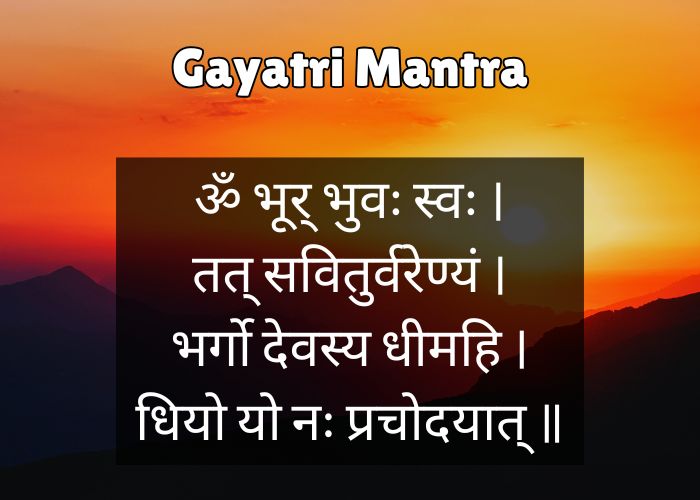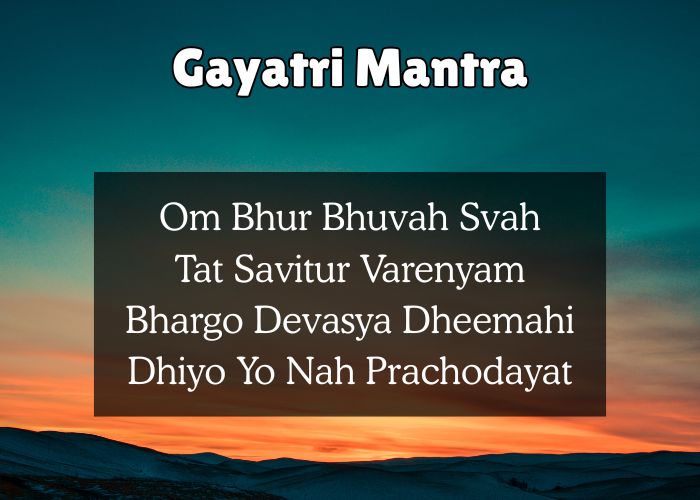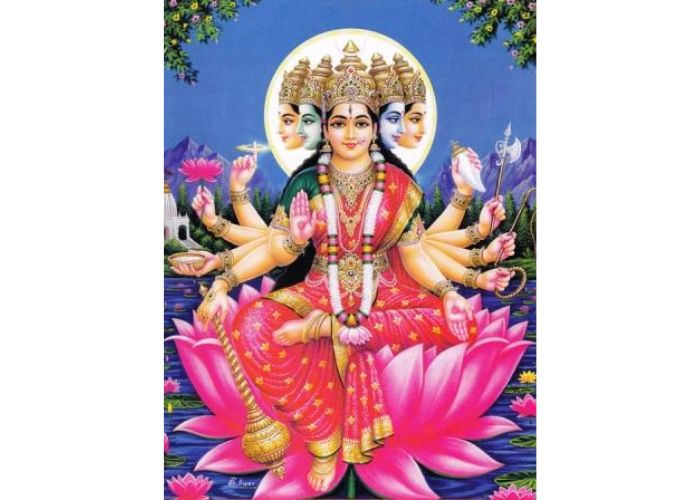The Gayatri Mantra is one of the most powerful and sacred mantras in Hinduism. It is a short prayer from the ancient Vedas that asks for light, wisdom, and guidance. Many people chant it daily to bring peace, focus, and positive energy into their lives.
This mantra is more than just words. It connects us to the divine and helps us grow spiritually. In this blog post, you will learn everything about the Gayatri Mantra with meaning, its benefits, how to chant it, and the Gayatri Mantra in English for easy understanding.
Whether you are new to chanting or have heard this mantra many times before, this guide will help you understand its true power and how it can bring light into your life.
What is Gayatri Mantra?
The Gayatri Mantra is a sacred Vedic chant found in the Rigveda (Mandala 3.62.10). It is a prayer to the Sun God, Savitur, asking for wisdom, light, and spiritual guidance. The mantra is dedicated to awakening the mind and purifying thoughts.
It is called the “mother of all mantras” because of its deep spiritual power. Chanting the Gayatri mantra brings peace, focus, and clarity.
Gayatri Mantra in Sanskrit
Following is the original Gayatri Mantra in Sanskrit:
ॐ भूर् भुवः स्वः ।
तत् सवितुर्वरेण्यं ।
भर्गो देवस्य धीमहि ।
धियो यो नः प्रचोदयात् ॥

Gayatri Mantra in English
Om Bhur Bhuvah Svah
Tat Savitur Varenyam
Bhargo Devasya Dheemahi
Dhiyo Yo Nah Prachodayat

What it Means:
“We meditate on the divine light of the Supreme Being (Savitur), who creates and sustains all worlds. May that light illuminate and guide our intellect.”
Gayatri Mantra Meaning
The meaning of Gayatri Mantra is: “We meditate on the divine light of the Creator. May that supreme power guide our thoughts and understanding.”
1. Om Bhur Bhuvah Svah
These three words are called the Mahavyahrti, meaning the “great utterances.”
They represent the three worlds:
- Bhur – the physical world (Earth)
- Bhuvah – the mental world (Atmosphere)
- Svah – the spiritual world (Heaven)
This part shows that the mantra connects all levels of existence.
2. Tat Savitur Varenyam
- Tat means “that,” referring to the Supreme God.
- Savitur means “of the Sun” or the Divine Creator.
- Varenyam means “adorable” or “worthy of worship.”
Together, this line means: We adore and worship that divine light of the Creator.
3. Bhargo Devasya Dheemahi
- Bhargo means the divine radiance or spiritual light.
- Devasya means “of the divine being” (God).
- Dheemahi means “we meditate upon.”
This line says: We meditate on the shining light of the divine.
4. Dhiyo Yo Nah Prachodayat
- Dhiyo means our intellect or understanding.
- Yo means “who.”
- Nah means “our.”
- Prachodayat means “may inspire or guide.”
This line is a prayer: May that divine light guide our minds and thoughts in the right direction.
Gayatri Mantra: Origin and History
The Gayatri Mantra is one of the most ancient and powerful mantras in Hinduism. It is found in the Rigveda (Mandala 3, Hymn 62, Verse 10), which is considered the oldest known scripture in the world. This mantra is a prayer to the Sun God (Savitur), seeking spiritual light, wisdom, and guidance.
Who wrote the Gayatri Mantra?
The Gayatri Mantra was written by Sage Vishwamitra, one of the most respected sages in Vedic history. He composed this mantra after intense meditation and spiritual realization. Through this verse, he offered humanity a timeless tool for inner clarity and connection with the supreme consciousness.
Why is it called Gayatri Mantra?
It is called the Gayatri Mantra because it is composed in a specific Vedic meter known as Gayatri Chhanda, which has 24 syllables. The name also refers to Goddess Gayatri, the divine form of light, knowledge, and purity.
Who is Goddess Gayatri?
Goddess Gayatri is the divine personification of the Gayatri Mantra, called the Mother of the Vedas. She represents wisdom, purity, and spiritual light, and is considered one of the most powerful forms of the divine feminine in Hinduism.
Though many know “Om Bhur Bhuva Swaha Gayatri Mantra” as a sacred chant, not everyone knows that this mantra is believed to have taken the form of a goddess. She is worshipped as an incarnation of Saraswati, the goddess of knowledge, or as Savitri, the divine energy of the Sun God (Savitur).
Symbolism of Goddess Gayatri

- Five faces representing the five pranas (life forces) and five senses.
- Ten arms holding scriptures, a lotus, a rosary, and weapons—signifying knowledge, power, and purity.
- Seated on a red lotus, which symbolizes awakening and transformation.
- She shines with divine light, just like the Sun, whose energy she channels through the Gayatri Mantra in Sanskrit.
Spiritual Significance of Gayatri Mantra
The Gayatri Mantra holds a central place in the Vedas and is considered a universal mantra that anyone, from any background, can chant to grow spiritually.
A Call to Divine Light
At its core, the Gayatri Mantra is a prayer to the Sun God (Savitur)—not just the physical sun, but the spiritual light of truth and consciousness that removes darkness from the mind and soul. By chanting this mantra, we invite that divine light to guide our thoughts, actions, and life decisions.
Know about the Significance of Sun.
Awakening the Intellect
The mantra specifically prays for the awakening of the “Dhi” or intellect. It helps sharpen the mind, improve clarity, and strengthen our ability to understand truth. That’s why students, thinkers, and spiritual seekers have been chanting it for centuries.
Inner Purification
Chanting the Gayatri Mantra has a powerful cleansing effect—not only mentally and emotionally, but also energetically. It helps release stress, reduce negative emotions, and bring peace to the heart and mind.
Universal Connection
The mantra begins with “Om Bhur Bhuva Swaha”, which connects us with the three worlds—physical, mental, and spiritual. It aligns the individual with the cosmic energy that flows through everything. This makes the chant a bridge between the individual soul (Atman) and the universal soul (Brahman).
Benefits of Gayatri Mantra Chanting
Scientific studies and ancient yogic wisdom both agree that chanting Gayatri mantra regularly brings calmness, focus, and better health.
1. Reduces Stress and Anxiety
One of the most well-known benefits of Gayatri Mantra is that it helps reduce stress and anxiety. The slow and rhythmic chanting relaxes the nervous system, lowers the stress hormone (cortisol), and brings a sense of peace. People who chant it regularly feel more calm and emotionally balanced throughout the day.
2. Improves Concentration and Focus
Chanting the Gayatri Mantra trains the brain to stay present. It improves your ability to focus and concentrate, especially helpful for students or those with a busy mind. The repetition of the mantra keeps distractions away and improves mental discipline.
3. Boosts Memory and Cognitive Function
Another important benefit of Gayatri Mantra is that it improves brain function. Regular chanting can sharpen your memory, make thinking clearer, and enhance decision-making skills. This happens because the mantra stimulates the frontal lobe of the brain, which is responsible for intelligence and logic.
4. Balances Emotions
People who chant the Gayatri Mantra often experience better control over their emotions. It helps manage feelings like anger, fear, and sadness. As a result, it brings emotional stability, which is essential for inner peace and healthy relationships.
5. Enhances Breathing and Heart Health
Chanting the Gayatri Mantra involves slow, deep breathing, which naturally calms the heart rate and improves lung function. This controlled breathing has a positive effect on heart health and also helps in reducing blood pressure over time.
6. Increases Positive Energy
The sound vibrations created by chanting the mantra purify the environment and increase positive energy. It not only uplifts your own mood but also creates a peaceful atmosphere around you. That’s why many people chant it before starting their day or while meditating.
7. Improves Sleep Quality
People suffering from insomnia or disturbed sleep often find comfort in the Gayatri Mantra. Chanting it before bedtime relaxes the mind, clears negative thoughts, and prepares the body for deep, restful sleep.
8. Supports Healing and Immunity
Chanting creates a state of mental calm, which directly supports the body’s healing process. A relaxed mind helps the immune system function better, making you less likely to fall sick and recover faster from illness.
9. Stimulates the Pineal Gland (Third Eye)
The vibrations of the Gayatri Mantra activate the area between the eyebrows, where the pineal gland (also called the third eye) is located. This helps in developing inner awareness, intuition, and spiritual clarity.
10. Promotes Mindfulness and Self-Awareness
Chanting this mantra every day builds mindfulness. It helps you become more aware of your thoughts, actions, and feelings. This awareness allows you to make better choices and live a more conscious and meaningful life.
11. Builds Mental Discipline
One of the hidden benefits of Gayatri Mantra is that it builds strong mental discipline. Chanting daily requires patience, consistency, and willpower. Over time, this builds inner strength and a sense of self-control.
12. Aligns Brain Hemispheres
Scientific studies show that chanting mantras helps balance both the left and right hemispheres of the brain. This balance improves creativity, logic, emotional control, and helps in developing a well-rounded personality.
Best Time for Gayatri Mantra Chanting
The best time for Gayatri Mantra chanting is during Sandhya timings—early morning at sunrise, and evening at sunset. These are peaceful moments when the environment and mind are naturally calm, making it easier to focus and absorb the spiritual energy of the mantra.
How to Chant Gayatri Mantra?
Step 1: Choose a Peaceful Place
Find a quiet and clean spot where you won’t be disturbed. It can be in your home, near a window, or even in a temple.
Step 2: Sit in a Comfortable Posture
Sit with your spine straight, either in Padmasana (Lotus Pose), Sukhasana (Cross-legged Pose), or on a chair. Keep your body relaxed and your hands in your lap or on your knees.
Step 3: Face the Right Direction
Face east in the morning or west in the evening. These directions are connected to the rising and setting sun, enhancing the mantra’s effect.
Step 4: Close Your Eyes and Take Deep Breaths
Take a few slow, deep breaths to calm your mind. Let go of all distractions and bring your full attention to the present moment.
Step 5: Start With “Om”
Begin by chanting “Om” slowly three times. It helps set the tone and clears the mind.
Step 6: Chant the Gayatri Mantra
Recite the mantra slowly and clearly:
Om Bhur Bhuvah Svah
Tat Savitur Varenyam
Bhargo Devasya Dheemahi
Dhiyo Yo Nah Prachodayat
You can chant it silently in your mind or softly out loud.
Step 7: Use a Japa Mala (Optional)
If you want to keep count, use a bead mala and chant once per bead. This helps build focus and consistency by chanting 108 times Gayatri Mantra.
Step 8: Keep Your Mind Focused
While chanting, focus on the sound, the meaning, or visualize the Sun or divine light shining within you.
Step 9: End with Gratitude
After finishing your chanting, sit quietly for a minute and feel the peace within. You can offer a small prayer or simply say “Thank you” in your heart.
Chanting Gayatri Mantra: Rules
- Chant during Sandhya times: sunrise or sunset
- Face east in the morning, west in the evening
- Sit with a straight spine in a clean, quiet place
- Begin with a few deep breaths and “Om” chanting
- Chant with devotion, focus, and a calm mind
- Use a 108-bead japa mala for counting (optional)
- Do not rush—chant slowly and clearly
- Maintain purity of body and mind
- Best practiced on an empty stomach
- Consistency is key—chant daily if possible
- Do not chant for show—chant with sincerity
- Preferably chant after a bath or freshening up
- Don’t chant during menstrual cycles (as per traditional views; optional based on belief)
Know about the symbols of spirituality.
Gayatri Mantra in Different Scriptures
Gayatri manatra appears in several sacred texts across Vedic and post-Vedic literature. These references show how central and timeless this mantra is in Indian spiritual traditions.
Rigveda (Mandala 3, Hymn 62, Verse 10)
The original source of the Gayatri Mantra is the Rigveda, which is the oldest of the four Vedas. It is found in Mandala 3, Sukta 62, Verse 10, and was composed by Rishi Vishwamitra. This verse is a prayer to Savitur, the Sun God, asking for divine light to guide our intellect.
Yajurveda
The mantra also appears in the Yajurveda, where it is used in rituals and yajnas (fire offerings). It is included in the Sandhya Vandana—a daily practice of reciting prayers during dawn, noon, and dusk.
Samaveda
In the Samaveda, which is known for its musical chants, the Gayatri Mantra is included in various melodic forms (saman). These are sung during Vedic rituals and are meant to invoke the divine through vibration and sound.
Smritis and Dharma Shastras
Texts like Manu Smriti and Parashara Smriti describe the Gayatri Mantra as essential for Brahmacharya (student life) and spiritual development. It is prescribed as the mantra to be taught during the Upanayana (sacred thread ceremony) for young boys in traditional households.
Bhagavad Gita (Chapter 10, Verse 35)
In the Bhagavad Gita, Lord Krishna says:
“Among the hymns of the Vedas, I am the Gayatri.”
This statement highlights the supreme importance of the Gayatri Mantra as the most powerful and representative of all Vedic chants.
Upanishads
Several Upanishads, like the Chandogya Upanishad, mention and reflect upon the deeper philosophical meaning of the Gayatri Mantra. They describe it as a symbol of ultimate knowledge and the bridge between the soul and the supreme.
Must Read: Hanuman Chalisa in English.
Gayatri Mantra for Different Gods
Shiva Gayatri Mantra
ॐ तत्पुरुषाय विद्महे महादेवाय धीमहि।
तन्नो रुद्रः प्रचोदयात्॥
Meaning: We meditate on the great Purusha (cosmic being) and Mahadeva. May that Rudra inspire and guide our intellect.
Know about the 108 Names of Lord Shiva.
Vishnu Gayatri Mantra
ॐ नारायणाय विद्महे वासुदेवाय धीमहि।
तन्नो विष्णुः प्रचोदयात्॥
Meaning: We meditate on Narayana and Vasudeva. May Lord Vishnu enlighten our intellect.
Ganesha Gayatri Mantra
ॐ एकदन्ताय विद्महे वक्रतुण्डाय धीमहि।
तन्नो दन्तिः प्रचोदयात्॥
Meaning: We meditate upon the one-tusked Lord with a curved trunk. May that tusked one (Ganesha) inspire and guide us.
Lakshmi Gayatri Mantra
ॐ महालक्ष्म्यै च विद्महे विष्णुपत्नी च धीमहि।
तन्नो लक्ष्मीः प्रचोदयात्॥
Meaning: We meditate upon Mahalakshmi, the consort of Vishnu. May the Goddess of wealth and prosperity enlighten us.
Durga Gayatri Mantra
ॐ कात्यायनाय विद्महे कन्याकुमारि धीमहि।
तन्नो दुर्गा प्रचोदयात्॥
Meaning: We meditate upon Goddess Katyayani and the youthful virgin. May Durga guide and inspire our mind.
Hanuman Gayatri Mantra
ॐ आञ्जनेयाय विद्महे वायुपुत्राय धीमहि।
तन्नो हनुमान् प्रचोदयात्॥
Meaning: We meditate upon Anjaneya, the son of the Wind God. May Hanuman inspire and energize our intellect.
Saraswati Gayatri Mantra
ॐ वाग्देव्यै च विद्महे कामराजाय धीमहि।
तन्नो देवी प्रचोदयात्॥
Meaning: We meditate upon Goddess Saraswati, the deity of speech and knowledge. May she guide and enlighten our mind.
Surya Gayatri Mantra (The original one)
ॐ भूर् भुवः स्वः
तत्सवितुर्वरेण्यं
भर्गो देवस्य धीमहि
धियो यो नः प्रचोदयात्॥
Meaning: We meditate on the divine light of the Sun God. May it guide our intellect and thoughts.
Krishna Gayatri Mantra
ॐ देवकीनन्दनाय विद्महे वासुदेवाय धीमहि।
तन्नो कृष्णः प्रचोदयात्॥
Meaning: We meditate on Devaki’s son, Vasudeva. May Lord Krishna guide and bless us.
Dattatreya Gayatri Mantra
ॐ दत्तात्रेयाय विद्महे अवधूताय धीमहि।
तन्नो दत्तः प्रचोदयात्॥
Meaning: We meditate on Dattatreya, the supreme Avadhuta. May he enlighten our minds.
Must Read: Top Bhagavad Gita Slokas.
FAQs About Gayatri Mantra
The Gayatri Mantra was written by the sage Vishwamitra and is found in the Rigveda.
Ideally, 108 times a day, but chanting as per your time and devotion also brings benefits.
Yes, while it is traditionally chanted during Sandhya, it can also be chanted at night with devotion.
There is one main Gayatri Mantra, but there are different versions dedicated to various deities like Shiva, Vishnu, and Ganesha.
Yes, it is one of the most powerful mantras for mental peace, wisdom, and spiritual growth.
Yes, absolutely. In modern understanding, the Gayatri Mantra can be chanted by anyone, including women.
Because it connects the chanter to divine light and wisdom. It also purifies the mind and improves focus.
It was written thousands of years ago in the Rigveda, one of the oldest scriptures in the world.
Yes, chanting it regularly helps clear negative thoughts and create positive vibrations.
Yes, children can chant it slowly and learn its meaning over time.
Both are fine. Aloud helps with sound vibration, while silent chanting deepens focus.


